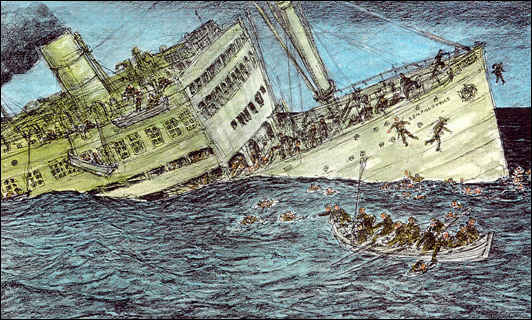| HOME |
 |
 |
|
| — Drawing by Richard Rockwell, a nephew of Norman Rockwell | |
| Solvay soldier among the victims of the Leopoldville disaster |
|
One of the little-known tragedies of World War 2 was the sinking of a troop-carrying ship in the English Channel in 1944. Among the 800 victims was Pvt. Vincent Paci, an 18-year-old from Solvay. |
|
|
|
Norman Bullett of Mattydale, New York, was one of the survivors of the sinking of the SS Leopoldville in the English Channel. He was 18 years old at the time. In December, 1996, Bullett was interviewed by David Tobin of the Syracuse Post-Standard. Bullett said he couldn't swim, but was forced to learn quickly when the troop-carrying ship, a converted Belgian ocean cruiser, fell victim to a torpedo from a Nazi submarine. Bullett managed to reach a wooden stairway floating in the rough water, grabbed it and held on. He said he saw hundreds of men float around him in water that was about 48 degrees. About 2,200 troops were aboard the Leopoldville; more than 800 died. The victims included soldiers from 46 states. All were members of the 66th Panther Infantry Division headed to relieve American troops at the Battle of the Bulge. One of the victims was Pvt. Vincent Paci, an 18-year-old from Solvay, who is buried in France. Bullett says the Leopoldville left Southampton, England, at 9 a.m. on December 24. The torpedo struck the ship about 6 p.m. The attack was so unexpected that there was no plan, no preparation, only chaos. "I thought, 'I'm going to save myself,' Bullett told Tobin, adding that he couldn't let his parents down. "The would be devastated if they got a telegram that I was lost." Bullett said he was in the cold water about 45 minutes before he was pulled out of the channel by three Coast Guard seamen. He couldn't stand; his legs were too numb. Luckily, he was not seriously injured. After a day of rest, Bullett and the other survivors headed off to fight the Germans. Here is another recollection from one of the rescuers: |
|
|
| For more on Solvay way back when, check out the Solvay-Geddes Historical Society |
| HOME | CONTACT |